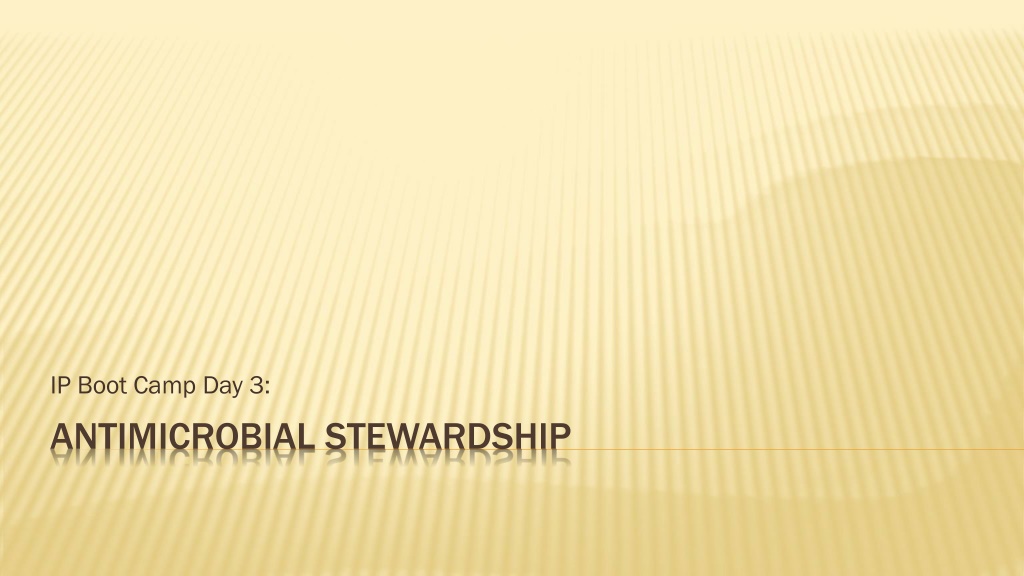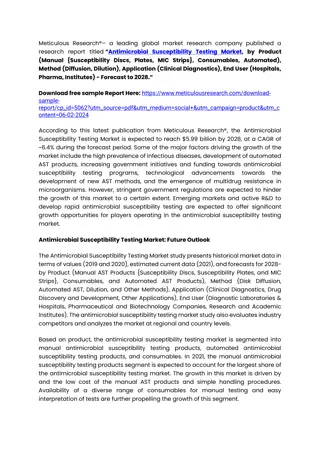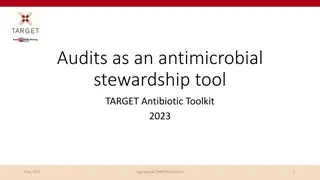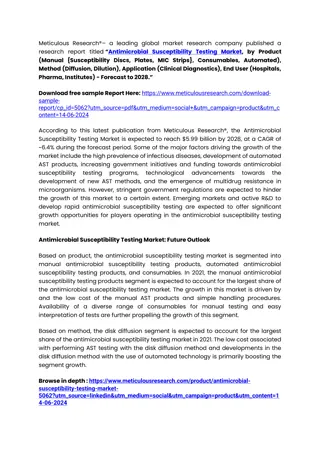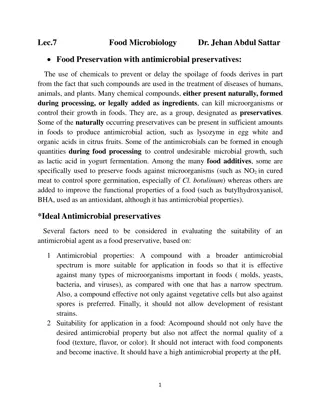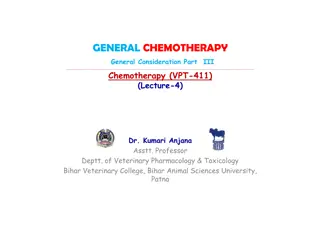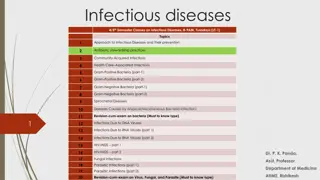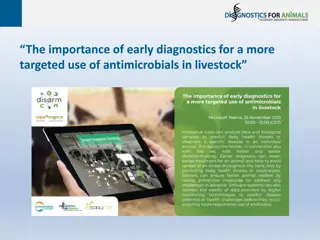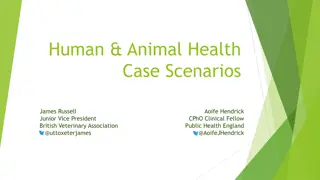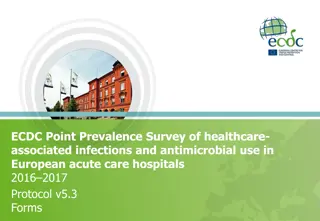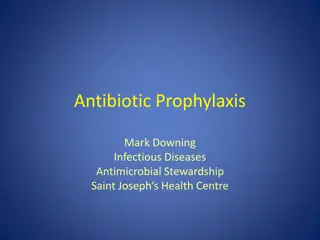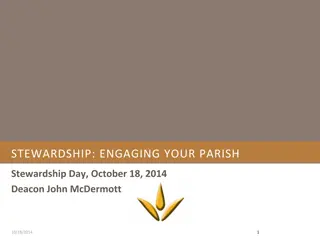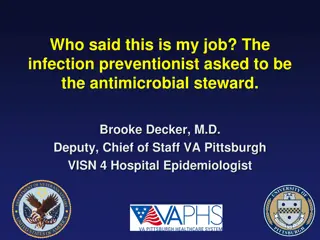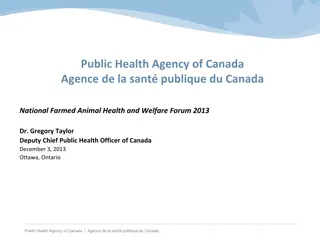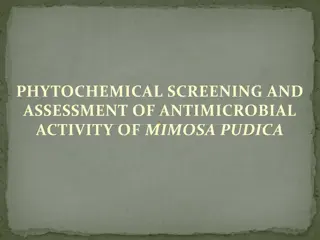Understanding Antimicrobial Stewardship: Key Concepts and Importance
Explore the critical aspects of Antimicrobial Stewardship, including its definition, historical background, and the impact of antimicrobial resistance. Learn about the basics, such as the relationship between antimicrobial use and resistance patterns, as well as the importance of optimizing antimicrobial use for improved patient outcomes.
Download Presentation

Please find below an Image/Link to download the presentation.
The content on the website is provided AS IS for your information and personal use only. It may not be sold, licensed, or shared on other websites without obtaining consent from the author. Download presentation by click this link. If you encounter any issues during the download, it is possible that the publisher has removed the file from their server.
E N D
Presentation Transcript
IP Boot Camp Day 3: ANTIMICROBIAL STEWARDSHIP
TODAYS PLAN What is AMS? How do I do it? How do we know it s working?
QUICK PLUG- HELP US WITH A SURVEY! AK is participating in an initiative to get stewardship in every LTC! We need your help with a survey about current status, strengths, and barriers https://www.surveymonkey.com/r/8Y88GH9 Please fill it out!
The Basics of Antimicrobial Stewardship The future of humanity and microbes will likely evolve as episodes of our wits versus their genes. -Dr. Joshua Lederberg RYAN STEVENS, PHARMD, BCPS INFECTIOUS DISEASES CLINICAL PHARMACY SPECIALIST PROVIDENCE ALASKA MEDICAL CENTER
Background: Sir Alexander Fleming: Discovered penicillin in 1928 Nobel Prize in Physiology/Medicine in 1945 New York Times article from 1945: the microbes are educated to resist penicillin and a host of penicillin-fast organisms are bred out In such cases the thoughtless person playing with penicillin is morally responsible for the death of the man who finally succumbs to infection with the penicillin resistant organism. I hope that this evil can be averted. Infect Control Hosp Epidemiol 2012;33(4):322-327
Background: Antimicrobial resistance is consistently increasing within the United States. The rate of new antimicrobial development has slowed significantly as of late. FDA approval rate of new antimicrobial agents decreased by 56% between 1983 and 2002.
Resistance: A few basic truths Change in antimicrobial use = change in resistance patterns. Resistance is more common in healthcare -acquired/associated infections vs. community acquired. Patients with resistant, healthcare associated infections are more likely to have received previous antimicrobial therapy than control patients. Even within an institution, higher antimicrobial use = higher rates of resistance in hospital-acquired infections. The longer a patient is exposed to an antimicrobial the more likely they will become colonized with an organism resistant to that antimicrobial.
Definition: Antimicrobial Stewardship Program (noun): An ongoing effort by a health care institution to optimize antimicrobial use among hospitalized patients in order to: Improve patient outcomes Reduce adverse and unintended consequences of antimicrobial use Ensure cost-effective therapy. Clin Microbiol Rev 2005;18(4):638-656
How did we get here? CDC Core Elements of Antimicrobial Stewardship - 2014 Unbridled antimicrobial utilization + Increasing resistance = Impending doom IDSA Guidelines (Round 1 2007) Various pay for performance and vague regulatory measures 2015 CDC Core Elements for Antibiotic Stewardship in Nursing Homes and Long Term Care. Increasing research pertaining to antimicrobial stewardship 2017 Implementation of Antibiotic Stewardship Core Elements at Small and Critical Access Hospitals National Action Plan - 2015 PCAST Report on Antibiotic Resistance - 2014 JCAHO Standard MM.09.01.01 - 2017 CMS CoP Revision 2017-2018 IDSA Guidelines (Round 2 2016) More AMS
Strategies: Primary Strategies: Prospective audit with intervention and feedback Formulary Restriction Secondary Strategies: Update: Integration of rapid diagnostic testing Specific guidelines CAP Febrile Neutropenia Dose optimization Beta-lactam infusion time optimization. Education Guideline/clinical pathway development De-escalation Antimicrobial order sets (i.e. use of the eHR) Dose optimization IV to PO conversion No longer recommended: Antimicrobial cycling Combination therapy CID 2007;44:159-77 CID 2016; ePub ahead of print 4/13/2016. DOI: 10.1093/cid/ciw118
5 Ds of Antimicrobial Stewardship: Diagnosis (provided?/confirmation?) Drug selection Dose optimization De-escalation opportunity Duration of therapy 1. 2. 3. 4. 5.
Case 1 Today s date: 9/15/2017 88 y/o male Resident at nursing home. PMH: Dementia, HTN, HLPD, CABGx2, DM RN notes that patient was slightly more altered than usual on two evenings prior (9/13). Urine was brown and foul smelling at that time and the RN sent it off for UA with reflex culture. Patient was started on levofloxacin 750 mg daily at that time ordered duration = 10 days. 9/13 labs/cultures/vitals: WBC 9.7 (3% bands), SCr 1.8 (CrCl 27 ml/min), BUN 32 UA: brown, 4+ leukocyte esterase, >150 WBC, nitrite positive, 1+ bacteria VS: HR 90, RR 19, BP 155/95, Tmax 99.2 Urine cultures: GNR E. coli (see image) Blood cultures: NGTD@48hrs.
Case 2: Today s date: 9/17/2017 72 y/o female (55 kg / 5 7 ) Resides at home Discharge 3 days ago from PAMC where she was admitted for CHF complicated by CLABSI (K. pneumonia: Ceftriaxone Keflex x 14 total days) and C. difficile (14 days PO flagyl) PMH: CHF, CAD, STEMI, Angina, s/p CABGx2, COPD Comes into ED 9/15 with chief complaint of shortness of breath. CXR: Bilateral lower lobe infiltrates vs. atelectasis vs. pulmonary edema. 9/15 labs/cultures/vitals: WBC 13.5 (11% bands), SCr 1.4 (CrCl 55 ml/min), BUN 20, BNP 965 Sputum cultures: gram stain 2+ mixed flora @ 24 hrs / <10 wbc / >25 epithelial cells Blood cultures: NGTD@48hrs. VS: HR 111, RR 32, BP 120/80, Tmax 99.5 Started on Ceftriaxone 2 g daily x 7 days + azithromycin 500 mg PO daily x 3 days
Case 3: Today s date: 9/17/2017 56 y/o male (145 kg / 5 8 ) Community Resident. PMH: CHF, HTN, HLPD, Cellulitis/folliculitis, Presents to ED 9/15 with RLE cellulitis. Extensive erythema and warmth with clearly demarcated borders. Started 2 days prior to admit. No crepitus. LLE is also slightly swollen and red, but less so than the right. No open wounds. CT RLE: Subcutaneous edema consistent with cellulitis in clinical context. No subcutaneous abscess, fluid collection, or gas. Patient was started on vancomycin 2500 mg loading dose followed by 1500 mg IV q8h + piperacillin/tazobactam 3.375 g IV q8h (over 4 hours) with an estimated duration of 10 days. 9/15 labs/cultures/vitals: WBC 19 (17% bands), SCr 0.67 mg/dL, BUN 20 VS: HR 110, RR 27, BP 102/65, Tmax 101.7 Wound culture (smear): 1+ GPF (no beta-strep/no staph aureus) Blood cultures: 2/2 GPC pairs/chains
Case 4: Today s date: 9/17/2017 42 y/o female (85 kg / 5 6 ) Resides at ALF PMH: Trauma (MVA) with quadriplegia, suprapubic catheter, HTN, depression, schizophrenia Presents to ED 9/15 with 2 day history of hypertension. BP on admit 195/100. Also flushed and febrile (102F in ED). Skin intact (small sacral decubitus without acute changes, erythema, or purulence). No shortness of breath, nausea, vomiting, diarrhea. CXR: No acute cardiopulmonary abnormalities. CT Pelvis: Small amount of right hydronephrosis with perinephric stranding. 9/15 labs/cultures/vitals: WBC 16 (19% bands), SCr 1.04, BUN 45 UA: 4+ LE, WBC >150, 3+ bacteria, Nitrite positive Urine cultures: 2+ E. coli (sensitivity panel attached) Blood cultures: NGTD@48hrs. VS: HR 90, RR 20, BP 165/95, Tmax 100.5 Started on Ceftriaxone 1 g daily (9/15) and narrowed to nitrofurantoin 100 mg PO bid x 5 remaining days today (9/17)
Case 5: 67 y/o male (86 kg / 6 1 ) Resides in community Seen by cruise ship PA 2 weeks ago for sinusitis and given clindamycin 300 mg tid x 7 days. PMH: ESRD (HD MWF), prostate cancer (actively receiving radiation), DM, diverticulitis Comes into ED 9/15 complaining of abdominal pain, distention, and diarrhea. Is concerned he is having another bout of divericulitis . CT abdomen: Pancolitis. 9/15 labs/cultures/vitals: WBC 32 (27% bands), SCr 3.2 (HD patient) Stool cultures: 3+ usual flora Stool lactoferrin: Positive Blood cultures: NGTD@48hrs. VS: HR 119, RR 21, BP 120/80, Tmax 103 Started on Levofloxacin 750 mg daily + Flagyl 500 mg PO tid x 10 days for diverticulitis/infectious colitis C. diff PCR positive on 9/16 Levofloxacin discontinued and duration of flagyl kept the same (10 day).
5 Ds of Antimicrobial Stewardship: Diagnosis (provided?/confirmation?) Drug selection Dose optimization De-escalation opportunity Duration of therapy 1. 2. 3. 4. 5.
Building a LTC ASP IP Bootcamp for LTC, October 11, 2017 Lori Chikoyak, RN BSN
THE REAL REASON I DO WHAT I DO
Objectives Participants will be able to define an Antimicrobial Stewardship Program (ASP) for LTC Participants will be able to list the Core Elements of AS Participants will build a potential action plan to develop an ASP in their LTC Participants will have fun https://www.youtube.com/watch?v=KQMX2ixD_Cs&index=19&list=PLLVjG YhU0zQZe7qgsZIRhZTtW1TA8j7mH
The most important concept for this presentation is contained in these pictures what is it? Reference: http://www.businessinsider.com/what-the-finished-la-sagrada-familia-church-in-barcelona-will-look-like-in-2026-2013-10
CMS: Regulatory F881 483.80(a) Infection prevention and control program. The facility must establish an infection prevention and control program (IPCP) that must include, at a minimum, the following elements: 483.80(a)(3) An antibiotic stewardship program that includes antibiotic use protocols and a system to monitor antibiotic use. INTENT The intent of this regulation is to ensure that the facility: Develops and implements protocols to optimize the treatment of infections by ensuring that residents who require an antibiotic, are prescribed the appropriate antibiotic; Reduces the risk of adverse events, including the development of antibiotic- resistant organisms, from unnecessary or inappropriate antibiotic use; and Develops, promotes, and implements a facility-wide system to monitor the use of antibiotics.
CDCs 7 Core Elements of Antibiotic Stewardship for LTCs Obtained from: https://www.cdc.gov/longtermcare/pr evention/antibiotic-stewardship.html
Leadership Commitment Write statements in support of improving antibiotic use to be shared with staff, residents and families Include stewardship-related duties in position descriptions for the medical director, clinical nurse leads, and consultant pharmacists in the facility Communicate with nursing staff and prescribing clinicians the facility s expectations about use of antibiotics and the monitoring and enforcement of stewardship policies Create a culture, through messaging, education, and celebrating improvement, which promotes antibiotic stewardship Nursing home leaders commit to improving antibiotic use. Facility leadership, both owners and administrators, as well as regional and national leaders if the facility is part of a larger corporation, can demonstrate their support in the following ways:
Accountability Nursing homes identify individuals accountable for the antibiotic stewardship activities who have the support of facility leadership: Empower the medical director Empower the director of Nursing Engage the consultant pharmacist Nursing home antibiotic stewardship leads utilize existing resources to support antibiotic stewards efforts by working with the following partners: Infection prevention program coordinator Consultant laboratory State and local health departments
Work with a consultant pharmacist who has received specialized infectious diseases or antibiotic stewardship training. Partner with antibiotic stewardship program leads at the hospitals within your referral network. Develop relationships with infectious disease consultants in your community interested in supporting your facility s stewardship efforts. Drug Expertise Nursing homes establish access to individuals with antibiotic expertise to implement antibiotic stewardship activities. Receiving support from infectious disease consultants and consultant pharmacists with training in antibiotic stewardship can help a nursing home reduce antibiotic use and experience lower rates of positive C. difficile tests. Examples of establishing antibiotic expertise include:
Take Action Through Policy and Practice Change to Improve Antibiotic Use Nursing homes implement prescribing policies and change practices to improve antibiotic use. The introduction of new policies and procedures which address antibiotic use should be done in a step-wise fashion so staff become familiar with and not overwhelmed by new changes in practice. Policies that support optimal antibiotic use Broad interventions to improve antibiotic use Pharmacy interventions to improve antibiotic use Infection and syndrome specific interventions to improve antibiotic use
Tracking and Reporting Antibiotic Use and Outcomes Process measures: Tracking how and why antibiotics are prescribed Antibiotic use measures: Tracking how often and how many antibiotics are prescribed Antibiotic outcome measures: Tracking the adverse outcomes and costs from antibiotics Nursing homes monitor both antibiotic use practices and outcomes related to antibiotics in order to guide practice changes and track the impact of new interventions. Data on adherence to antibiotic prescribing policies and antibiotic use are shared with clinicians and nurses to maintain awareness about the progress being made in antibiotic stewardship.
Education Nursing homes provide antibiotic stewardship education to clinicians, nursing staff, residents and families. Nursing homes sustain improvements by incorporating both education and feedback to providers. Nursing homes engage residents and their family members in antibiotic use and stewardship educational efforts to ensure clinicians have their support to make appropriate antibiotic use decisions.
Building an Antibiotic Stewardship Program (ASP) Gather a Team Assign Roles and Responsibilities Complete a Readiness Assessment Implementation-First Meeting Priorities Draft Policies and Procedures for the ASP
Choose members to serve on the Antimicrobial Stewardship Program team Director of Nurses Charge Nurse Pharmacist Leadership Medical Director Infection Preventionist IT (EHR help) Resident/ Resident Representative
Gather a Team Familiarize the team with antimicrobial stewardship CDC s Core Elements of Antibiotic Stewardship in Nursing Homes CDC s About Antimicrobial Resistance: A Brief Overview CDC s Antibiotic/Antimicrobial Resistance: References and Resources CDC s Antibiotic Resistance Threats in the United States (2013) (see more resources at the end of this PPT too)
Gather a Team Appoint two champions to promote the importance of an antimicrobial stewardship program in the nursing home. These champions should have the following qualities: A basic knowledge of antibiotics An interest in playing a leadership role in the nursing home The respect of his or her peers An understanding of how to be a good team player An understanding of the importance of improving antibiotic use in nursing homes
Assign Roles and Responsibilities Assign initial roles and responsibilities. Champions: develop agendas and policies, lead training, provide leadership and support Stewardship staff: Help develop training, review use of tools, remind staff to use tools, help solve problems with implementation Monitoring staff: Abstract data for monitoring, develop findings and communicate to track assigned roles them
Roles, Responsibilities, and Tasks Co-champion and infection control lead. Co-develop agendas. Lead trainings. Monitor the new intervention. Draft policies and procedures; obtain necessary review and approval for new policies and procedures. Help develop staff training. Review whether materials are used. Develop findings related to monitoring the new intervention. Name Example Title Phone & Email 000-000-0000, name@organization.n et Assistant Director of Nursing
Complete a Readiness Assessment Is the Nursing Home Ready? Yes No Is key leadership supportive of this effort? Support by leadership (i.e., the board and/or administrator, director of nursing, or medical director) is critical to change. Is the medical director actively involved in quality improvement and/or infection control? Is the nursing home financially stable? Is the nursing home s ownership and/or management stable (i.e., no changes anticipated over the next six months)? Is the nursing home in good standing with the State Survey Agency (e.g., not identified as a Special Focus Facility, not under State receivership, has not had admissions frozen)? Are there at least two staff who can serve as program champions and commit to leading the activity? Program champions could include (but are not limited to) the director of nursing, assistant director of nursing, charge nurse(s), infection prevention consultant/practitioner, and the medical director or other prescribing clinician. It is critical that at least two, if not more, staff are willing to lead the effort and champion it. Is there time to train staff? Implementation will require training for nursing staff and possibly prescribing clinicians, depending on the toolkit. Initial training for nurses and prescribing clinicians may take approximately 30 minutes to 2 hours. Are there sufficient resources (e.g., time, funds) to cover such training? Are there sufficient funds to make copies of materials for nurses, prescribing clinicians, and, as appropriate, residents and family members? Are there resources for implementing mechanisms to sustain the effort (e.g., staff who can train new nurses as they are hired and include the topic in the annual education program)? The key to sustaining any new activity is ensuring everyone is knowledgeable about it.
Use the CDCs AS Checklist
Implementation-First Meeting Priorities Person Responsible Amount of Time Agenda Topic Action Items Overview of purpose of an Antimicrobial Stewardship Program 5 minutes Overview of toolkit/tools to be implemented 10 minutes Discussion of changes to workflow Step-by-step discussion of what toolkit use would look like in nursing home (e.g., where blank forms are kept, how they will be handled in the workflow, where will completed forms be kept, etc.) Determine individuals responsible for specific processes and steps Identify potential barriers and how to address them Start-up activities: Identify activities to be carried out to use the tools (e.g., creation of new forms, data collection, meetings or letters for communication, trainings, etc.) What is a realistic timeline for starting the program? This estimate should consider time for training, developing policies, and informing others (such as the prescribing clinicians and labs). Schedule monthly team meeting to review progress and address questions/problems Identify the next steps and agenda for next meeting 20 minutes 10 minutes 5 minutes 5 minutes 5 minutes
Draft Policies and Procedures for the ASP The policy should include the following information and should be provided to staff prior to a new intervention: 1. A statement of the nursing home s commitment to quality care 2. A statement of the purpose and scope of the program, including what the antimicrobial stewardship program plans to accomplish 3. A description of the program and its goals 4. The date the new program will begin 5. A list of who will participate in the new program
Draft Policies and Procedures for the ASP A set of procedures should be developed and communicated before each intervention toolkit is introduced. New procedures should include the following information: 1. The goal(s) of the intervention 2. What tools will be used 3. The date on which the procedures were issued or revised 4. How the intervention will be implemented 5. Identification of the staff responsible for the intervention 6. Required documentation signed by nursing home management authorized to approve the intervention 7. If applicable, a description of how information about the intervention will be communicated to prescribing clinicians and/or other facilities such as hospitals 8. A description of how and when training for nursing staff and, if applicable, prescribing clinicians, will be conducted 9. A description of what quality monitoring will include
Table of Contents: Minnesota Sample Antibiotic Stewardship Policy for Long-Term Care Facilities BACKGROUND ............................................................................................................................. 2 POLICY ......................................................................................................................................... 2 PROCEDURE ................................................................................................................................ 3 1. Leadership ........................................................................................................................... 3 2. Accountability (Antibiotic Stewardship Team) ................................................................... 3 3. Antibiotic Expertise ............................................................................................................. 4 4. Antibiotic Stewardship Actions ........................................................................................... 4 5. Measuring Actions (Tracking) ............................................................................................. 6 6. Reporting ............................................................................................................................. 7 7. Education ............................................................................................................................ 7 REFERENCES ................................................................................................................................ 7 APPENDIX A. Loeb Criteria for Initiating Antibiotics ................................................................... 8 APPENDIX B. Standardized Form for Assessing and Communicating Suspected UTI ................. 9 APPENDIX C. Standardized SBAR Form for Communication of Change in Condition ............... 11 APPENDIX D. Criteria for Submission of Biologic Specimens for Laboratory Diagnostics ........ 13 Part 1. Urine culture .............................................................................................................. 13 Part 2. Algorithm to guide Clostridium difficile diagnostics.................................................. 13 APPENDIX E. Measurement Protocols ...................................................................................... 14 Part 1. Antibiotic Use ............................................................................................................ 14 Part 2. Stewardship Actions .................................................................................................. 14 Part 3. Outcomes .................................................................................................................. 15
YOUR TURN!! BRINGING IT HOME
Resources Crnich CJ, Drinka P. Improving the management of urinary tract infections in nursing homes: it s time to stop the tail from wagging the dog. Ann Longterm Care 22(9). Crnich CJ, Duster M, Hess T, et al. Antibiotic resistance in non-major metropolitan skilled nursing facilities: prevalence and interfacility variation. Infect Control Hosp Epidemiol. 2012 Nov;33(11):1172-4. Dellit TH, Owens RC, McGowan JE Jr, et al. Infectious Diseases Society of America and the Society for Healthcare Epidemiology of America guidelines for developing an institutional program to enhance antimicrobial stewardship. Clin Infect Dis. 2007 Jan 15;44(2):159-77. Drinka PJ, Crnich CJ, Nace DA. An antibiotic prescription induces resistance at the individual level more than the group level. J Am Med Dir Assoc. 2013 Sep;14(9):707-8. Drinka P, Podzorski RP, Griffin V, et al. Antibiogram of urinary isolates. J Am Med Dir Assoc. 14(6):443. Gugkaeva Z, Franson M. Pharmacist-led model of antibiotic stewardship in a long-term care facility. Ann Longterm Care. 2012;20(10):22-6. Jump RL, Olds DM, Seifi N, et al. Effective antimicrobial stewardship in a long-term care facility through an infectious disease consultation service: keeping a LID on antibiotic use. Infect Control Hosp Epidemiol. 2012;33(12):1185-92. Nace DA, Drinka PJ, Crnich CJ. Clinical uncertainties in the approach to LTC residents with possible UTI. J Am Med Dir Assoc 2014 Feb; 15: 133- 139. Smith, PW, Watkins K, Miller H, et al. Antibiotic stewardship programs in long-term care facilities. Ann Longterm Care. 2011;19(4):20-25. Wisconsin Department of Health Services, Division of Quality Assurance. Antibiotic use in nursing homes. 2014 Oct. Publication P-00886. Accessed from https://www.dhs.wisconsin.gov/publication/p00886.pdf
Resources AHRQ, multiple resources located at: https://www.ahrq.gov/nhguide/index.html Monitor, and Sustain an Antimicrobial Stewardship Program. Content last reviewed October 2016. Agency for Healthcare Research and Quality, Rockville, MD. http://www.ahrq.gov/nhguide/toolkits/implement-monitor- sustain-program/index.html http://www.health.state.mn.us/divs/idepc/dtopics/antibioticresistance/asp/lt c/ http://www.health.state.mn.us/divs/idepc/dtopics/antibioticresistance/asp/lt c/ A2SC Resource page: http://www.ashnha.com/antimicrobial- stewardship/a2sc-resources/
QUESTIONS? COMMENTS? Contact information for Lori: Lori Chikoyak, RN, BSN Antimicrobial Stewardship Project Manager (c) 907-690-5495 lchikoyak@mpqhf.org
REGULATORY REQUIREMENT FOR ANTIBIOTIC STEWARDSHIP Shelley White, RN Cert/Licensing PROGRAM
